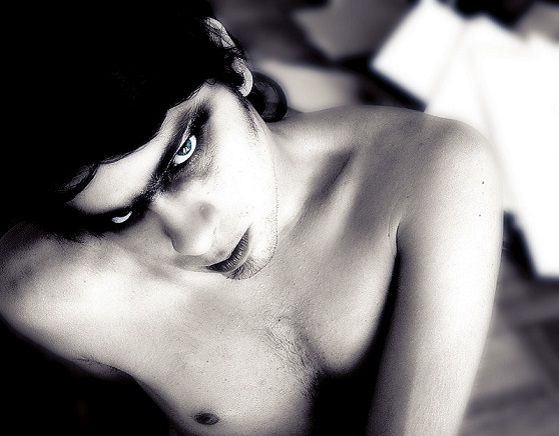Finding My Own Light in the Darkness.

{source}
On the night of the New Moon, I felt a phase of renewal within darkness, representing the burgeoning of new forms still unseen above ground.
Since no moonlight lit the sky that night, it allowed other heavenly bodies to be seen more clearly in the deeper hues. The hushed heavens were reflected below, the somber streets were being called a ghost town.
I live on the top floor of my building, in apartment number eight.
From this vantage, I can see the strange new movements in the still, dusky air.
A richer, deeper twilight seems to engulf the usually frenetic hills.
A lone pair hurriedly walking a greyhound, even its leggy pace seems clipped, its tapered snout tilted solemnly down, the spartan rigidity spreading to all creatures beneath the heavy lidded sky.
Earlier on a run through the park, runners swerved around each other in exaggerated arcs. The coiled energy of restrained eddies roiled into streams of humanity contained in bubbles of tension, fear, restraint.
The market after was a seething Darwinian hothouse, varying levels of social breakdown rumbled through the stripped shelves. Usually in spring I like to have a cornucopia of fruit, overwhelming the bowl to drip wantonly onto the table.
I’ve never enjoyed chess, and contact sports less so, so I left with a rather motley assemblage. Eight Pink Lady apples that seem to have endured a rather arduous passage, a roughly handled couple of bananas patterned in the brown prints of brusque capture and abandonment, and a lemon that sits pinched and cynical beside the fruit bowl, both of us, it seems, wonder what it’s doing here.
San Francisco is under lockdown, we’ve been told to protect ourselves and each other from a terror that’s spread from The East, gripped Europe and now has America in its grasp.
The people in this city now do something unusual, we sit with ourselves, we face the unknown, we feel our fear and ambivalence and confront ourselves without the distraction of daily, modern life.
The passage of time flickers lightning quick in the city, people flutter through their quotidian paces as if borne on the cloud technology SF is now known for, reacting, responding and engaging with mercurial lightness.
The heaviness of survival is an unwelcome idea, especially in my neighborhood where the body is something to be managed, pampered, toned, its needs largely outsourced. Generally one is invited into the body, into presence, into breath and movement on these hills, by someone like me.
But now it feels as though a large amount of people living in mental worlds with conceptual demands have been thrust into their physical being, without so much as a spritz of lavender.
Now we wait in metaphoric darkness, this is uncomfortable for many so used to a near constant stream of distraction.
The descent into darkness is a mythic theme, and so too is the return from it.
We see this story in mythology and the natural cycles it reflects.
While I’ve sensed the near panic that reverberates through the city, manifesting in various iterations in different places, I’ve felt grateful for the space and silence.
As much as I have felt and responded to the moment vibrating with apprehension and alarm, I’ve also appreciated being able to take time to relate this event to a cyclic understanding of life, of collective experience and how patterns reoccur.
Rituals as simple as running an errand for an older neighbor, watering the plants or making tea take on a deeper, more calming dimension. The quiet beauty that can flourish within when quick responses and the voices of others cede to self-originating action and the steadiness of an inner voice.
It’s been a few weeks since the Spring Equinox, and during this time I’ve felt soothed by the stories and symbols people have told about the journey into darkness and the return to the light: Persephone was a Greek goddess of spring. Her vernal maidenhood symbolic of pure potential, embowered with her earth goddess mother, she is the embodiment of the Virgin archetype, forever blooming and becoming.
In myth, pairs of opposites attract each other, and Persephone’s innocence is in opposition to the brooding Pluto, god of the underworld, who abducts her and makes her his chthonian queen.
Her mother mourns and earth becomes cold and barren. Eventually, after an intercession, Persephone is allowed to return to the surface for half the year, and the earth once again becomes fertile and warm.
This tale of descent, sacrifice and return has older, Eastern roots, as many Greek deities and myths do.
I feel great satisfaction in finding threads in myth and tracing them to deeper realms of the collective psyche. In seeing the interplay of opposites and how their tension results in the stories of the past.
Inanna was the Sumerian Queen Of Heaven (predecessor of Ishtar, Astoreth and Aphrodite) who journeyed to the underworld: “From The Great Heaven She Set Her Mind On The Great Below” ~ The Descent Of Inanna
She is stripped of her raiment piece by piece at each of the underworld’s seven gates, she is naked and bowed low.
Inanna is treated as any mortal facing death, at her sister’s command.
In this tale, Inanna confronts her sister, Ereshkigal, queen Of The Great Below.
In this myth too, a being of the sunlit realm is held in darkness, there is an intercession on her behalf, and a sacrifice is made to appease both the places above and below.
There is a terracotta bas-relief called Queen Of The Night, which exemplifies the essence of this story for me. Part of what makes this relic so potent is the ambiguity of it, as scholars disagree on whether it depicts Inanna or her subterranean sister.
Aspects like the taloned feet and downward-pointing wings signify to some that it is Ereshkigal, while the lions suggest to others that it is Ishtar/Inanna, the lion being her totem animal. In my mind, the ambiguity of the image suggests a powerful aspect of the myth and the concept of facing one’s own darkness and death.
Whether it is The Queen Of Heaven or the Queen Of The Great Below, it is an image that suggests the renunciation of personal attributes which support, offer succor, stability and status. It evokes the stripping away of the sunlit realm and all its comforts.
It may be the moment before the goddess of heaven is divested, the moment Ereshkigal triumphs over her bowed sister, or the moment Inanna/Ishtar is reinstated and regains her ornaments of power. In any case, it is a point in a cycle between two polarities and offers a profoundly rich source of contemplation; the arc of hubris, domination and relieved return can be charted in one ancient visual.
Death is said to be the great equalizer, we must all face it naked and bowed low. While this fear of contagion has illuminated inequities in class, age and physicality, we are united in its mystery. The truth is its novelty makes it unknown to us. Young, healthy bodies are said to have been ravaged by it.
Facing the foreign in isolation is difficult for even the naturally solitary person, and the fear of death is the deepest terror we hold in our animal bodies. As we see in mythology, it has always been so for the human family.
Myths can be seen as our dreams, fears and fantasies, they depict the collective grappling with the unknowable. In the time of science, perhaps this novel malady can bring us closer to the archaic experience of a shared uncertainty and the cooperative storytelling it inspires.
Instead of blind fear in the face of something uncharted, perhaps a new moment of communal tales, shared observations and the comfort of a unified unveiling will emerge.
It could be that the novelty of a danger unknown to us that effects us all will allow us to unveil our own stories so we can truly step into the greater tale we all inhabit, without armor or retreat.
I’ve felt both the splintering of persona pitted against persona, and the withdrawal into solipsism this spring.
I’ve been both the fast moving, spandex-clad athlete, all cheekbone and elbows, and the hermit lost in worlds forgotten to the one within which I reside.
I wonder if some of the antidote to this crises is to uncover our stories, our darkness, our aggression and will to survive at all costs, our wicked sense of humor and our secret places where where our mind takes us to feel safe.
Not the saccharine baring of acceptable vulnerabilities, but the revealing of the complex beings we are, the way we can be both savage and tender, armored and vulnerable, day and night.
As the moon was dark in the sky that night, it allowed Venus to shine in brilliant ascendancy. Venus was higher in the sky than it had been in eight years, its apparitions repeat almost exactly in that rhythm.
As I looked up beneath the purpling sky, I realized that the darkness of the new moon was what allowed me to perceive this precious eight year cycle.
The union of opposites was a theme painted for me in shades of deep indigo and plum, in the dance of the sun and moon, shadow and light.
Released from the tight tether of the sun and not overcome by the moon, Venus illuminated their perfect correspondence. The harmony that can exist when both are balanced, when both can be seen in their wholeness, their shadow and light.
***
Maren Zweifler enjoys teaching Yoga with a focus on free movement and intrinsic shapes, emphasizing spinal fluidity and innate, primal posture. Deeply inspired by movement systems that embrace nature like Sridaiva and Continuum Movement. He completed a 500-hour certification in SF and has taught both there and in Austin where he honed his skills teaching private classes tailored to the individual needs of his clients. He created a wellness/yoga program at a non-profit. These experiences allowed him to explore both the unique individuation of the physical experience in one-on-one sessions, and the commonalities of the human form that can be witnessed in large groups. You could connect with Maren on Instagram.


